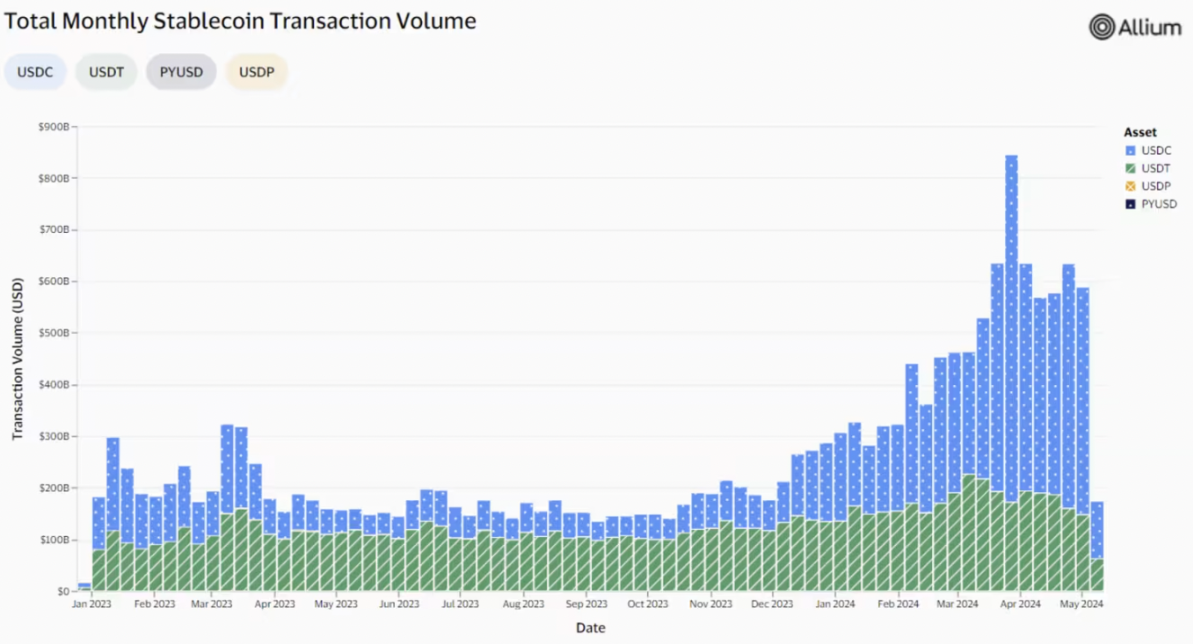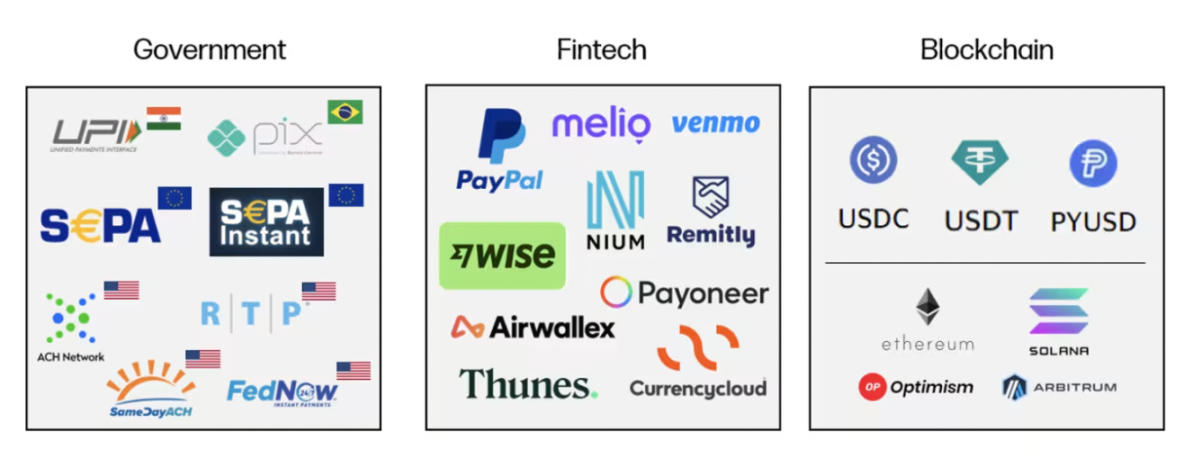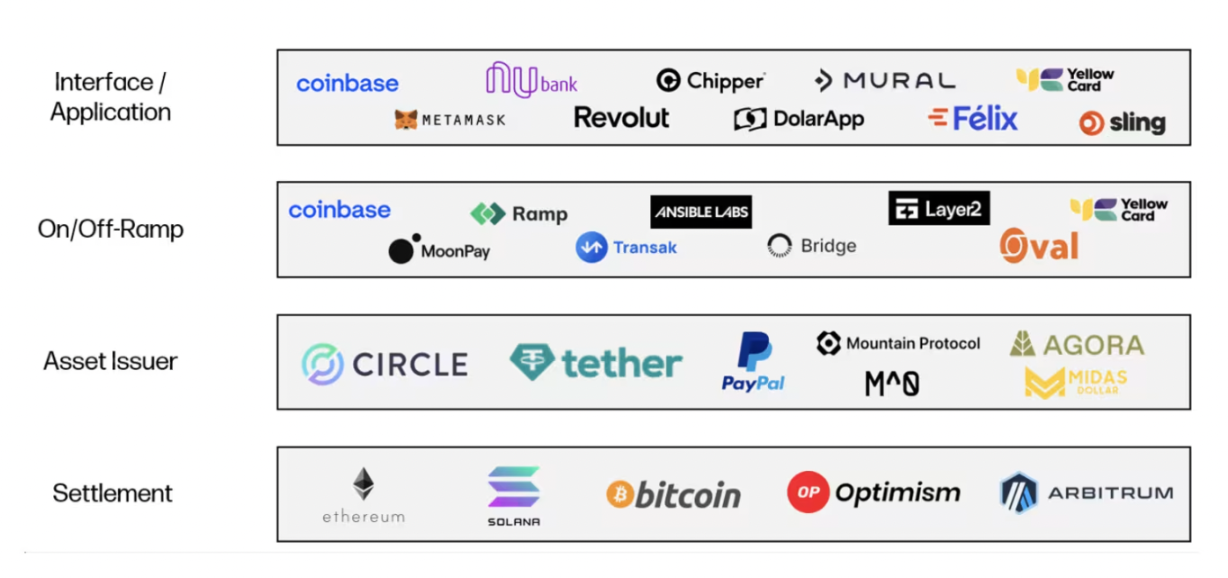Galaxy Partners: Cryptocurrency ادائیگیوں میں زبردست امکان ہے، Stablecoins ہر جگہ موجود ہوں گے۔
Original article by Mike Giampapa, General Partner, Galaxy Ventures
اصل ترجمہ: Luffy، Foresight News
Payments were the primary use case highlighted in the 2008 Bitcoin whitepaper. Over the past few years, blockchain-based payments have become increasingly viable and popular compared to traditional payment methods. Billions of dollars have been invested in developing the underlying blockchain infrastructure over the past decade, and now we have a system that can achieve payments at scale.
The cost and performance curve of blockchain is in line with Moores Law. In the past few years, the cost of storing data on the blockchain has dropped by several orders of magnitude. After Ethereums Dencun upgrade (EIP-4844), the average cost per transaction of Layer 2 networks such as Arbitrum and Optimism has also dropped to $0.01, and the transaction cost of alternative Layer 1 is close to a few cents.
In addition to better performing, cost-effective infrastructure, the rise of stablecoins has been explosive and persistent, and it is clearly a long-term trend in the volatile cryptocurrency industry. Visa recently launched a public-facing stablecoin dashboard (Visa Onchain Analytics), which provides a glimpse into this growth trend and shows how stablecoins and the underlying blockchain infrastructure are being used to facilitate global payments, with stablecoin transaction volume for the entire market growing by about 3.5 times year-on-year. When focusing the analysis on transaction volume that appears to be initiated directly by consumers and businesses (excluding automated transactions or smart contract operations), Visa estimates that stablecoin transaction volume in the past 30 days was approximately $265 billion (annualized volume of approximately $3.2 trillion), which is about twice PayPals payment volume in 2023 and is approximately equivalent to the GDP of India or the United Kingdom.

Source: Visa Onchain Analytics
We have spent a lot of time researching the underlying drivers of this growth and firmly believe that blockchain has great potential to become the mainstream payment method of the future.
Payment Industry Background
In order to grasp the fundamental drivers of the cryptocurrency payments market growth, we must first understand some historical context. The payment infrastructure used internationally today (e.g. ACH, SWIFT) was established more than 50 years ago in the 1970s. The ability to send money around the world was a groundbreaking achievement and a milestone in the financial world.
However, the global payments infrastructure is now largely outdated and fragmented. It is an expensive and inefficient system that operates within limited banking hours and relies on many intermediaries. A significant problem with the current payments infrastructure is the lack of global standards. Fragmentation hinders seamless international transactions and introduces complexity to establishing consistent protocols.
The emergence of real-time settlement systems is a major advance in recent years. The success of international real-time payment schemes, such as Indias UPI and Brazils PIX, is well documented. In the United States, government and consortium-led efforts have introduced real-time settlement systems such as Same Day ACH, the Clearing Houses RTP, and the Federal Reserves FedNow. The adoption of these new payment methods has been inhibited, with fragmentation among numerous competing interests creating significant challenges.
Fintech companies attempt to provide user experience improvements on top of this traditional infrastructure. For example, companies such as Wise, Nium, and Thunes enable customers to pool liquidity from accounts around the world so that they can make transactions feel instant. However, they do not break through the limitations of the underlying payment channels, nor are they capital-efficient solutions.
The complexity of today’s payments
Given the fragmented nature of the existing financial system, payment transactions are becoming increasingly complex. This situation can be best illustrated by the structure of cross-border payment transactions, which contain many pain points:

Source: Galaxy
-
Multiple intermediaries: Cross-border payments often involve multiple intermediaries, such as local and correspondent banks, clearing houses, foreign exchange brokers, and payment networks. Each intermediary adds complexity to the transaction process, leading to delays and increased costs.
-
Lack of standardization: Lack of standardized processes can lead to inefficiencies. Different countries and financial institutions may have different regulatory requirements, payment systems, and messaging standards, making it challenging to streamline payment processes.
-
Manual processing: Traditional systems lack automation, real-time processing capabilities, and interoperability with other systems, resulting in delays and manual intervention.
-
Lack of transparency: The opaque nature of cross-border payment processes can lead to inefficiencies. Limited visibility into transaction status, processing times, and associated fees can make it difficult for businesses to track and reconcile payments, leading to delays and administrative overhead.
-
High costs: Cross-border payments often incur high transaction fees, exchange rate markups, and intermediary fees.
Cross-border payments typically take up to 5 business days to settle and have an average fee of 6.25%. Despite these challenges, the market size for B2B cross-border payments remains large and continues to grow. FXC Intelligence estimates the total market size for B2B cross-border payments to be $39 trillion in 2023 and is expected to grow 43% to $53 trillion by 2030.
Obviously, real-time settlement is imminent, but a global unified payment standard has not yet emerged. Fortunately, there is a solution available to everyone to transfer value around the world instantly and cheaply – blockchain.

Source: Galaxy (All third-party company product and service names in this presentation are for identification purposes only)
Crypto Payment Adoption
Stablecoin payments offer an ideal solution to current challenges in areas such as cross-border payments, and are experiencing long-term growth around the world. As of May 2024, the total stablecoin supply is approximately $161 billion. USDT and USDC rank third and sixth in cryptocurrency market capitalization, respectively. Although their combined market capitalization accounts for only about 6% of cryptocurrencies, their on-chain transaction value accounts for about 60% of the entire crypto market.
Returning to our cross-border payments example, the simplified flow of funds provided by blockchain offers an elegant solution to the current complexity dilemma:

Source: Galaxy
-
Near-instant settlement: Blockchain can settle transactions nearly instantly across the globe, compared to most traditional financial payment methods that take days to settle.
-
Lower costs: Crypto payments are less expensive compared to existing products due to the elimination of various intermediaries and technological infrastructure.
-
Greater visibility: Blockchain provides a higher level of visibility in tracking the movement of funds and alleviating the administrative overhead of reconciliation.
-
Global Standards: Blockchain provides a “high-speed rail” that is easily accessible to anyone with an internet connection.
Stablecoins can greatly simplify the payment process and reduce the number of intermediaries. Compared with traditional payment methods, the flow of funds can be seen in real time, the settlement time is faster, and the cost is lower.
Overview of the Crypto Payment Stack
When we look at the crypto payments market, we see that there are four main layers to the stack:

Source: Galaxy (All third-party company product and service names in this presentation are for identification purposes only)
تصفیہ کی تہہ
The underlying blockchain infrastructure for settling transactions. Layer 1 blockchains such as Bitcoin, Ethereum, and Solana, as well as general-purpose Layer 2 blockchains such as Optimism and Arbitrum, are all selling block space to the market. They compete on multiple dimensions, including speed, cost, scalability, security, etc. We expect that over time, the payments use case will become a significant consumer of block space.
اثاثہ جاری کرنے والا
The asset issuer is the entity responsible for creating, maintaining and redeeming a stablecoin, which is a crypto asset that aims to maintain a stable value relative to an anchor asset or basket of assets (most typically the US dollar). Stablecoin issuers typically adopt a balance sheet-driven business model similar to that of a bank, where they take customer deposits and invest them in higher-yielding assets such as US Treasuries, then issue stablecoins as liabilities and profit from the interest rate spread or net interest margin.
Deposit and Withdrawal
Deposit and withdrawal providers play a key role in increasing the availability and adoption of stablecoins as a primary mechanism for financial transactions. Fundamentally, they act as a technology layer that connects stablecoins on the blockchain with fiat currencies and bank accounts. Their business models tend to be traffic-driven and take a small commission from the amount of dollars flowing through their platform.
Interface/ Application
A front-end application is ultimately the customer-facing software in the crypto payment stack that provides a user interface for crypto payments and leverages the rest of the stack to enable such transactions. Their business models vary, but tend to be some combination of a platform fee plus a traffic-driven fee generated through front-end transaction volume.
Emerging trends in the crypto payments space
There are a number of trends that excite us at the intersection of cryptocurrencies and payments:
Cross-border payments are the first battlefield
As mentioned above, cross-border transactions are often the most complex, inefficient, and expensive due to the numerous intermediaries that collect rents in the process. As a result, we see the highest uptake in the market for alternative blockchain-based payment solutions. Providers supporting B2B payments (payments to suppliers and employees, corporate treasury management, etc.) and remittance use cases are highlighted in the market.
We view cross-border payments as similar to logistics, where the “last mile” (entry and exit between fiat crypto) is particularly difficult to navigate. This is where businesses like Layer 2 Financial provide real value, as they take on the heavy lifting of integrating with the various crypto and fiat partners on the back end (blockchains, custodians, exchanges/liquidity providers, banks, traditional payment channels, etc.) and provide a seamless and compliant experience for customers. Layer 2 also helps facilitate high-speed/lowest-cost routes for transactions, and is able to complete the entire lifecycle of a cross-border payment using crypto in as little as ~90 minutes, 1-2 orders of magnitude faster than existing solutions.
Given the cost and efficiency gains, we are seeing adoption across all regions and end customers (crypto-native and traditional businesses). Demand is particularly high in regions where fiat currencies are less stable and the U.S. dollar is less convenient to use. For these reasons, Africa and Latin America have been hotbeds of entrepreneurial activity. For example, Mural has seen great success helping clients facilitate payments to suppliers and developer contractors between the U.S. and Latin America.
Supporting the early stages of payment-grade infrastructure
Most of the market infrastructure surrounding the crypto ecosystem (e.g., custody platforms, key management systems, liquidity venues) was built primarily for retail trading. Over the years, this ecosystem has matured to include more enterprise/institutional-grade software and services, but overall, this infrastructure was not built to support payments in real time and at scale.
We see opportunities for new entrants and existing providers to launch/expand their offerings to capture this emerging use case. For example, new custody/key management systems like Turnkey improve transaction signing efficiency by approximately 2 orders of magnitude, reducing signature latency to 50-100 milliseconds for millions of wallets. They also enable companies to design policies around asset operations to enhance automation and process scalability.
Liquidity partners are also re-aligning their products to provide more frequent (ideally real-time) settlement capabilities to deposit and withdrawal providers. More automation is being implemented across the board, which will provide a better experience for end users.
On-chain revenue will change the rules of the game
Issuing digital fiat currencies on the blockchain is the first instance of the tokenization trend. As mentioned above, we have seen significant growth in stablecoin adoption, but holders of these assets are unable to earn a yield on their holdings (relative to 4-5% for US Treasuries).
Currently, Tether/USDT and Circle/USDC dominate the stablecoin market, accounting for more than 90% of the ~$160 billion stablecoin market. Recently, we have seen a series of new entrants, offering on-chain yields in different forms. Stablecoin issuers such as Agora, Mountain, and Midas are offering yield assets pegged to the US dollar, providing yield or rewards to holders. We have also seen companies such as BlackRock, Franklin Templeton, Hashnote, and Superstate launch a series of tokenized US Treasury products to provide on-chain yields. Finally, we have seen creative tokenized structured products like Ethena offer a synthetic asset pegged to the US dollar, which uses ETH base transactions to provide on-chain yields.
We expect these new assets to be a huge catalyst for the expansion of on-chain finance. A market for yield-generating assets is being born, and we see a future where users can leverage specific instruments based on their use case, risk/return preferences, and the region they are located in. This could have a transformative impact on financial services around the world.
Early signs of stablecoin usefulness
While stablecoins have clear product-market fit across a variety of use cases, daily life for non-crypto natives is often conducted in the fiat world. For example, businesses may be happy to leverage stablecoins and blockchain for cross-border payments, but most companies today prefer to hold and accept fiat currencies.
One impediment is the ability for businesses to accept stablecoin payments. Stripe’s recent announcement of support for its merchant clients to accept stablecoins is a huge shift from the status quo. It can provide consumers with more payment options and make it easier for businesses to accept, hold, and trade digital assets.
Another inhibitor is the ability to use stablecoins. Visa has expanded stablecoin settlement capabilities to support tighter interoperability between blockchain and the Visa network. For example, we are seeing organic demand for stablecoin-backed card products that allow cardholders to use their stablecoins anywhere Visa cards are accepted.
As stablecoins become more widely accepted and used in traditional payment methods, we increasingly expect these digital assets to become ubiquitous alongside non-digital assets.
آخر میں
Blockchain-based payments are one of the most important and exciting trends we are seeing at the intersection of cryptocurrencies and financial services. We believe blockchain will be used to settle an increasing number of financial transactions, and that payments will become a key use case and major consumer of blockchain space in the future.
This article is sourced from the internet: Galaxy Partners: Cryptocurrency Payments Have Great Potential, Stablecoins Will Be Ubiquitous
متعلقہ: انجیکشن (INJ) قیمت استحکام میں پھنسی ہوئی ہے - کیا بریک آؤٹ قریب ہے؟
In Brief Injective price is back within the $45 and $35 barrier after marking an all-time high of $52. At the moment, most of the active addresses are the ones that are awaiting growth for profits. Whales, which control 84% of the supply, are idle and their resurgence will push price upwards. The Injective (INJ) price momentum turned bearish following the formation of its all-time high nearly two weeks ago. INJ is now recovering again, rising by more than 15% in the past three days, but will it be able to break consolidation? Injective Investors Are Pushing On Injective price is currently trading at $40.17, up from $35.02 just 72 hours ago. This has given bullish signs for investors once again, who were reeling from the 32% correction observed since…







